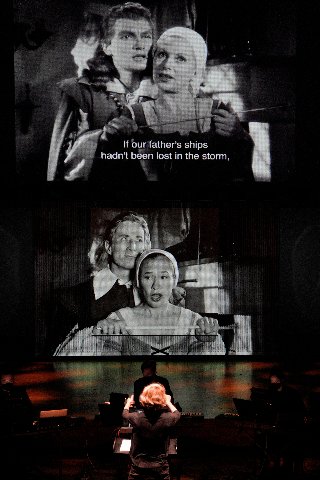La Belle et la Bête by Philip Glass
Opera Adapted from Cocteau
By: Victor Cordell - Jul 15, 2022
The black and white images in highly contrasted lighting glisten like ebony onyx and silver pearls. Enchantment virtually leaps off of the screen as the title characters conquer near insurmountable challenges and ultimately endear themselves to one another and to the audience. Such is Jean Cocteau’s enchanting 1946 film “La Belle et la Bête.”
In Philip Glass’s adaptation of a trilogy of Cocteau films to opera (the others being “Orphée” and “Les Enfants Terribles,” both previously produced by Opera Parallèle), the composer saved his most imaginative treatment for this most uncommon love story. To preserve the spellbinding charm of the source and the visual magic that can only be produced electronically, the movie is projected over the stage, while the soundtrack is stripped. Instead, Glass’s original musical score and libretto are performed live under the backdrop of the electronic images. But the four singers appear variously in the flesh and on the screen. The resulting hybrid is a unique and captivating performance experience. A triumph!
The story itself is better known to most from the Disney film and stage musical versions, both of which were wildly successful. The substance of any version is similar, an admixture of “The Hunchback of Notre Dame,” “Cinderella,” and “The Frog Prince.” Belle’s father inadvertently triggers the plot conflict by picking a rose for her from the Beast’s garden. The Beast condemns the old man to death, unless the latter sends one of his daughters to live with him. Of course, Belle consents, and so begins the rocky road between the title characters, slowly resulting in understanding, followed by empathy, and culminating in love.
The narrative has endless interpretations and is replete with symbolism in its objects, from mirror to white horse to key. The overarching moral of the story is about inclusion and acceptance for what a person is inside. OP recognized the broader implications of this theme and hosted a recent panel discussion connecting the story to LGBTQ and ethnic issues. This could not be more timely as the Republican party’s culture war rapidly reverses rights of transexuals; treats homosexuality as a deviance that is to be corrected; victimizes immigrants from minority communities; and vilifies legitimate protests of racial injustice such as Black Lives Matter, while turning a blind eye to white supremacy.
Like the composer, OP thrives on innovation. Director and Production Designer Brian Staufenbiel and his creative staff have masterfully combined elements, resulting in smoothly coordinated, multifaceted artistry. The performance of the opera sometimes results in sensory overload, and it can be difficult to absorb everything at once. Endless original projection arrays exhilarate. The one constant is Cocteau's film, with its light and darkness and its luminous leads, Josette Day and Jean Marais. Meanwhile, the delightful live lead characters, Vanessa Becerra as La Belle and Hadleigh Adams as La Bête, sometimes appear videoed on a screen below the film screen; sometimes are live on the stage; and other times sing in the darkness of the vomitorium (yes, that is a real word!). If there is a formula behind the whys and wheres of these manifestations, I didn’t figure it out. The omnium gatherum male and female singers, Eugene Brancoveanu and Sophie Delphis sit in costume with the orchestra for the greater part. All four singers are superb in their roles.
Philip Glass draws on numerous sources for his musical inspiration, and in many ways is an unconventional modern composer. His score of “La Belle et la Bête” is attractive, full of mystery, menace, and lush beauty. The orchestral lines of repetitive structures pulse with insistence throughout, provided by repeated keyboard pizzicato or percussion or even wind instruments. They reflect specific sounds such as horse hooves or clock chimes as well ambient drive.
Conductor Nicole Paiement leads the orchestra with boundless energy and the absolute precision required to synchronize all of the moving parts of this production. The orchestra of a mere seven pieces – three keyboards, three woodwinds, and percussion maps onto the Philip Glass Ensemble for which many of the composer’s works have been designed. The fullness of the sound produced belies the size of the orchestra, and both synthesizers and winds mimic sounds of a great variety of instruments from strings to brass.
For the patron who is accustomed to the extravagance of fully-staged opera, this clever, mixed entertainment might seem a bit eccentric. But it is a totally engaging, artistically valid, professionally mounted, and highly compelling production.
“La Belle et la Bête” with music and libretto by Philip Glass; performed to the movie created by Jean Cocteau; and based on the story “Beauty and the Beast” written by Jean-Marie Leprince de Beaumont; is produced by Opera Parallèle and co-presented by SF Jazz; and plays at SF Jazz Center, 201 Franklin Street, San Francisco, CA through July 17, 2022.

